Nursing Ethics: Ethical Dilemmas in Patient Care and Feeding Practices
VerifiedAdded on 2022/08/08
|6
|1037
|64
Essay
AI Summary
This essay delves into the ethical considerations surrounding patient care, particularly focusing on the dilemma of tube feeding versus comfort feeding for patients with advanced dementia. The author, a nursing student, argues against the routine use of nasogastric tubes, citing potential complications and the violation of patient autonomy. The essay supports the 'comfort feeding' approach, emphasizing the ethical principles of sanctity of life and beneficence. It also explores the emotional responses of nurses to ethical dilemmas, the importance of educating families, and the need to uphold patient self-determination. The author discusses the use of ethical principles like beneficence and non-maleficence in resolving conflicts and suggests systematic processes, including seeking mentor feedback, to navigate complex ethical situations in nursing practice. The essay references several studies and articles to support its arguments.
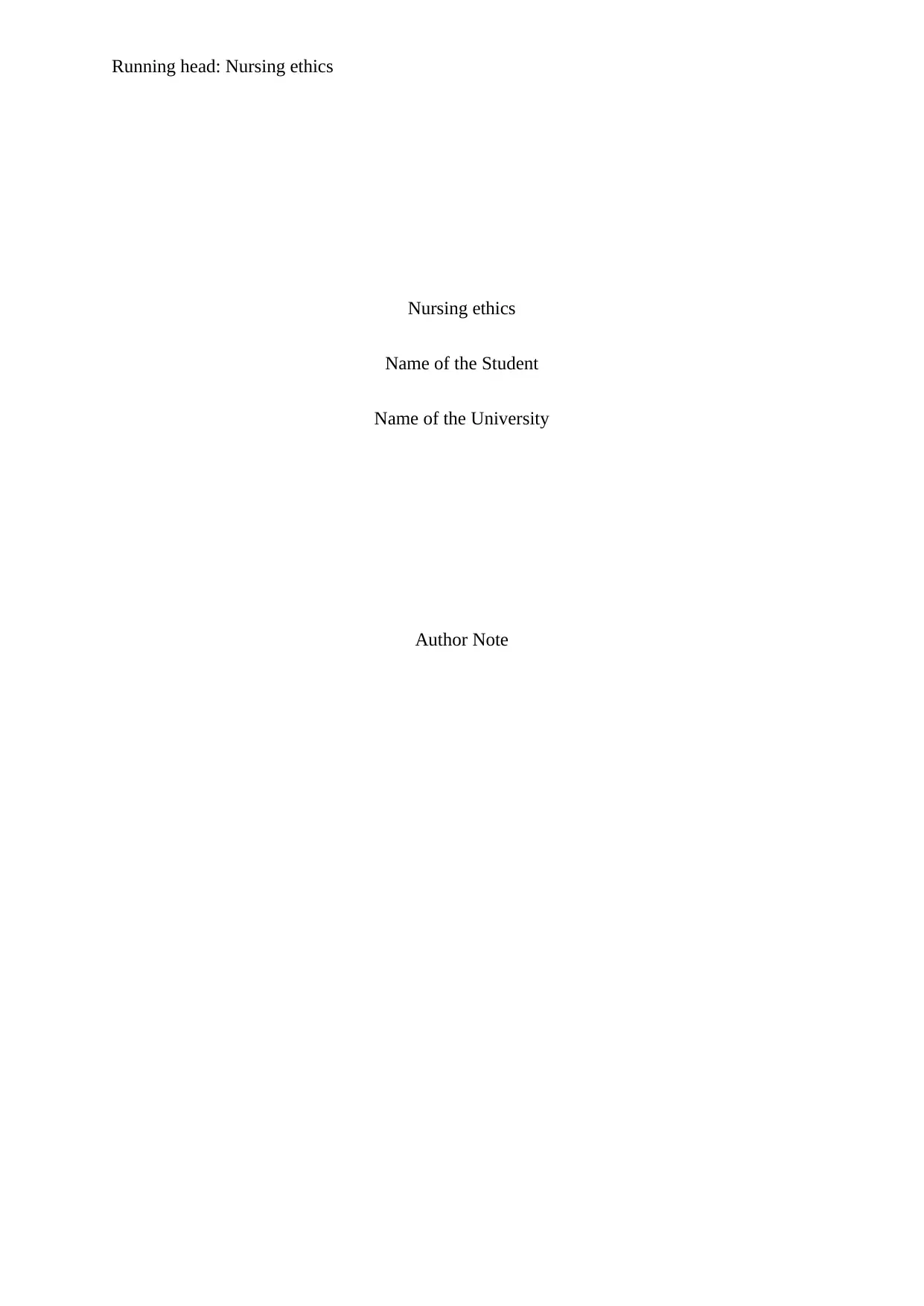
Running head: Nursing ethics
Nursing ethics
Name of the Student
Name of the University
Author Note
Nursing ethics
Name of the Student
Name of the University
Author Note
Paraphrase This Document
Need a fresh take? Get an instant paraphrase of this document with our AI Paraphraser
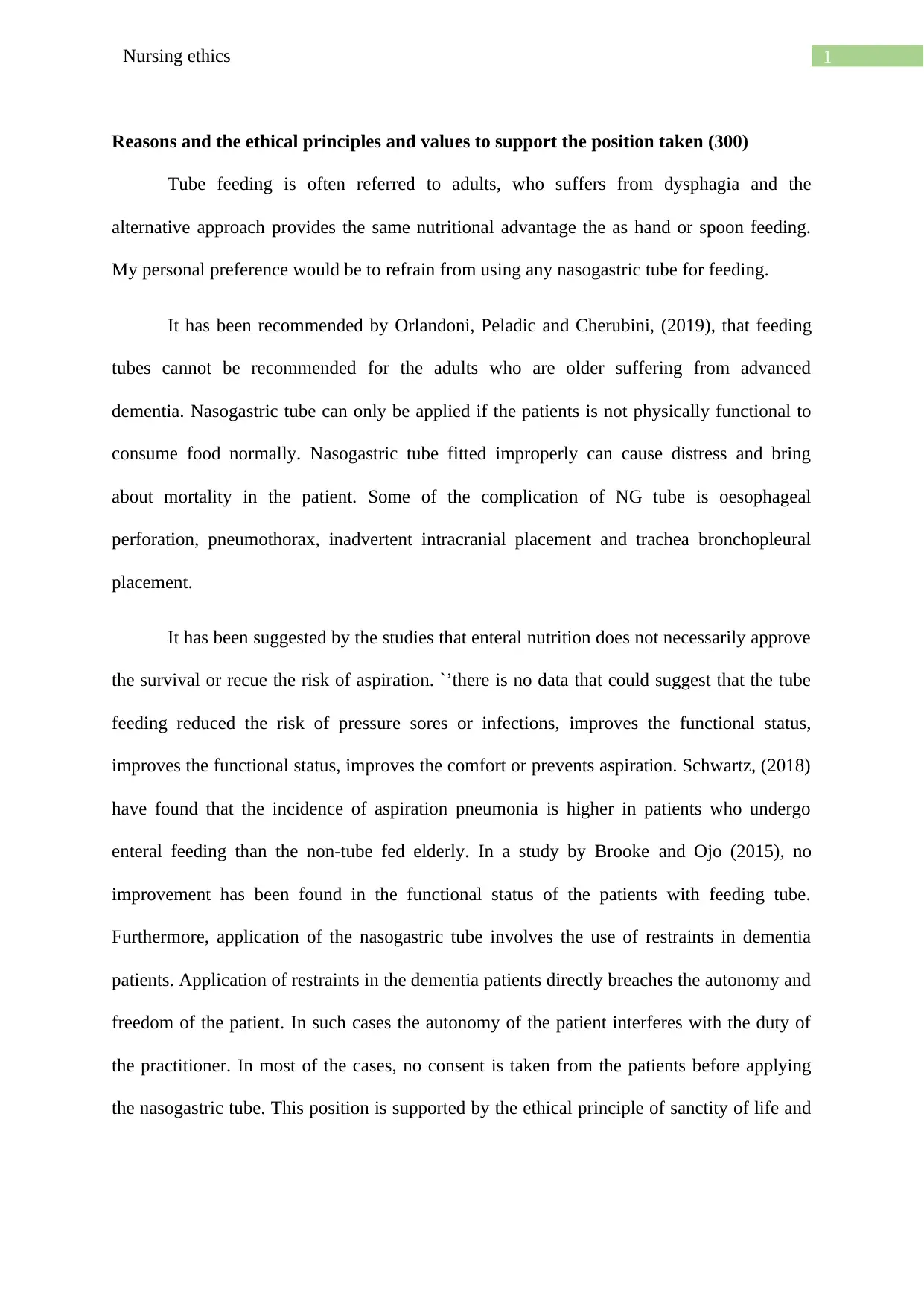
1Nursing ethics
Reasons and the ethical principles and values to support the position taken (300)
Tube feeding is often referred to adults, who suffers from dysphagia and the
alternative approach provides the same nutritional advantage the as hand or spoon feeding.
My personal preference would be to refrain from using any nasogastric tube for feeding.
It has been recommended by Orlandoni, Peladic and Cherubini, (2019), that feeding
tubes cannot be recommended for the adults who are older suffering from advanced
dementia. Nasogastric tube can only be applied if the patients is not physically functional to
consume food normally. Nasogastric tube fitted improperly can cause distress and bring
about mortality in the patient. Some of the complication of NG tube is oesophageal
perforation, pneumothorax, inadvertent intracranial placement and trachea bronchopleural
placement.
It has been suggested by the studies that enteral nutrition does not necessarily approve
the survival or recue the risk of aspiration. `’there is no data that could suggest that the tube
feeding reduced the risk of pressure sores or infections, improves the functional status,
improves the functional status, improves the comfort or prevents aspiration. Schwartz, (2018)
have found that the incidence of aspiration pneumonia is higher in patients who undergo
enteral feeding than the non-tube fed elderly. In a study by Brooke and Ojo (2015), no
improvement has been found in the functional status of the patients with feeding tube.
Furthermore, application of the nasogastric tube involves the use of restraints in dementia
patients. Application of restraints in the dementia patients directly breaches the autonomy and
freedom of the patient. In such cases the autonomy of the patient interferes with the duty of
the practitioner. In most of the cases, no consent is taken from the patients before applying
the nasogastric tube. This position is supported by the ethical principle of sanctity of life and
Reasons and the ethical principles and values to support the position taken (300)
Tube feeding is often referred to adults, who suffers from dysphagia and the
alternative approach provides the same nutritional advantage the as hand or spoon feeding.
My personal preference would be to refrain from using any nasogastric tube for feeding.
It has been recommended by Orlandoni, Peladic and Cherubini, (2019), that feeding
tubes cannot be recommended for the adults who are older suffering from advanced
dementia. Nasogastric tube can only be applied if the patients is not physically functional to
consume food normally. Nasogastric tube fitted improperly can cause distress and bring
about mortality in the patient. Some of the complication of NG tube is oesophageal
perforation, pneumothorax, inadvertent intracranial placement and trachea bronchopleural
placement.
It has been suggested by the studies that enteral nutrition does not necessarily approve
the survival or recue the risk of aspiration. `’there is no data that could suggest that the tube
feeding reduced the risk of pressure sores or infections, improves the functional status,
improves the functional status, improves the comfort or prevents aspiration. Schwartz, (2018)
have found that the incidence of aspiration pneumonia is higher in patients who undergo
enteral feeding than the non-tube fed elderly. In a study by Brooke and Ojo (2015), no
improvement has been found in the functional status of the patients with feeding tube.
Furthermore, application of the nasogastric tube involves the use of restraints in dementia
patients. Application of restraints in the dementia patients directly breaches the autonomy and
freedom of the patient. In such cases the autonomy of the patient interferes with the duty of
the practitioner. In most of the cases, no consent is taken from the patients before applying
the nasogastric tube. This position is supported by the ethical principle of sanctity of life and

2Nursing ethics
beneficence. Hence, I personally support the use of “comfort feeding” technique in feeding
patients with advance dementia like patient B.
beneficence. Hence, I personally support the use of “comfort feeding” technique in feeding
patients with advance dementia like patient B.
⊘ This is a preview!⊘
Do you want full access?
Subscribe today to unlock all pages.

Trusted by 1+ million students worldwide
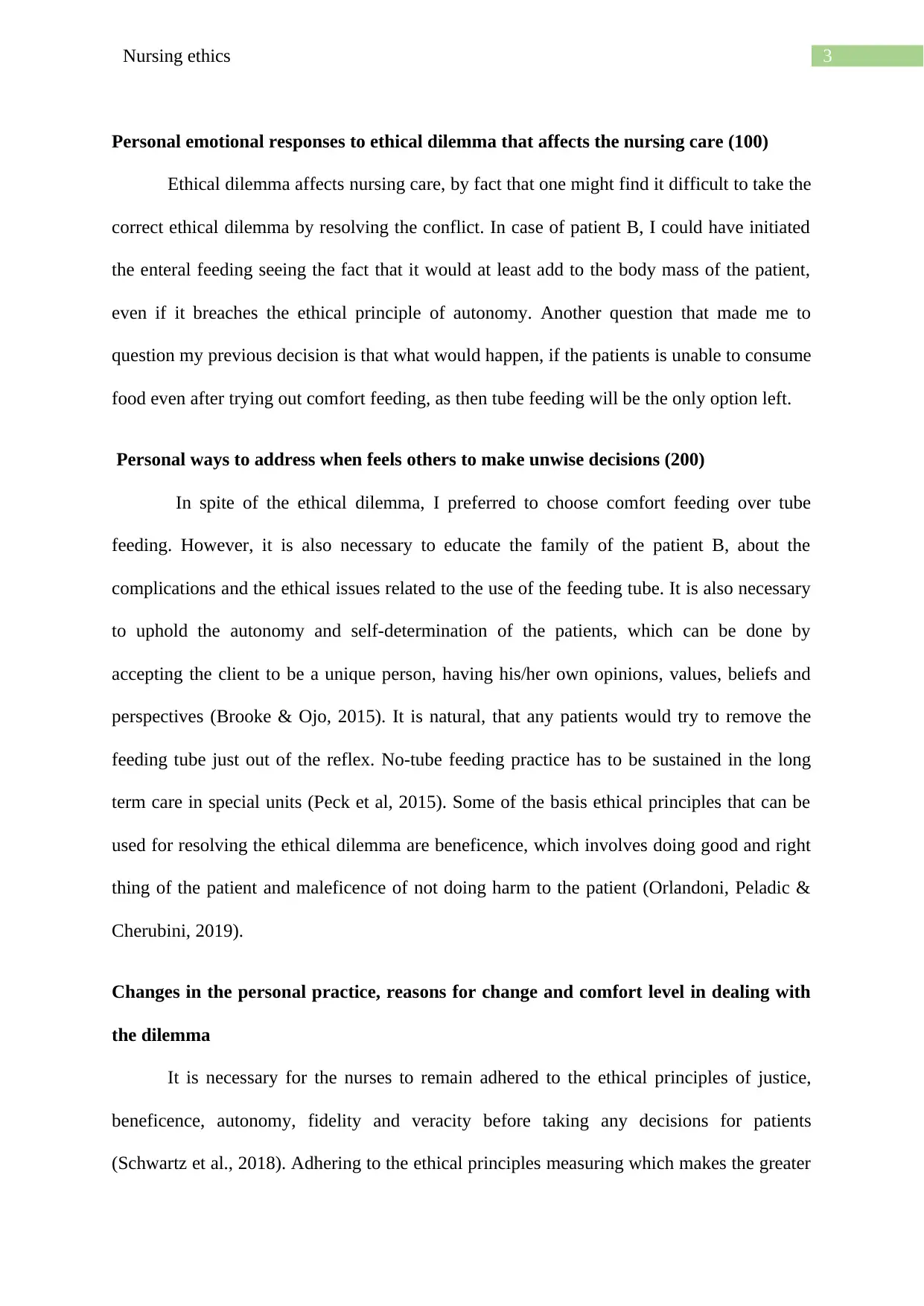
3Nursing ethics
Personal emotional responses to ethical dilemma that affects the nursing care (100)
Ethical dilemma affects nursing care, by fact that one might find it difficult to take the
correct ethical dilemma by resolving the conflict. In case of patient B, I could have initiated
the enteral feeding seeing the fact that it would at least add to the body mass of the patient,
even if it breaches the ethical principle of autonomy. Another question that made me to
question my previous decision is that what would happen, if the patients is unable to consume
food even after trying out comfort feeding, as then tube feeding will be the only option left.
Personal ways to address when feels others to make unwise decisions (200)
In spite of the ethical dilemma, I preferred to choose comfort feeding over tube
feeding. However, it is also necessary to educate the family of the patient B, about the
complications and the ethical issues related to the use of the feeding tube. It is also necessary
to uphold the autonomy and self-determination of the patients, which can be done by
accepting the client to be a unique person, having his/her own opinions, values, beliefs and
perspectives (Brooke & Ojo, 2015). It is natural, that any patients would try to remove the
feeding tube just out of the reflex. No-tube feeding practice has to be sustained in the long
term care in special units (Peck et al, 2015). Some of the basis ethical principles that can be
used for resolving the ethical dilemma are beneficence, which involves doing good and right
thing of the patient and maleficence of not doing harm to the patient (Orlandoni, Peladic &
Cherubini, 2019).
Changes in the personal practice, reasons for change and comfort level in dealing with
the dilemma
It is necessary for the nurses to remain adhered to the ethical principles of justice,
beneficence, autonomy, fidelity and veracity before taking any decisions for patients
(Schwartz et al., 2018). Adhering to the ethical principles measuring which makes the greater
Personal emotional responses to ethical dilemma that affects the nursing care (100)
Ethical dilemma affects nursing care, by fact that one might find it difficult to take the
correct ethical dilemma by resolving the conflict. In case of patient B, I could have initiated
the enteral feeding seeing the fact that it would at least add to the body mass of the patient,
even if it breaches the ethical principle of autonomy. Another question that made me to
question my previous decision is that what would happen, if the patients is unable to consume
food even after trying out comfort feeding, as then tube feeding will be the only option left.
Personal ways to address when feels others to make unwise decisions (200)
In spite of the ethical dilemma, I preferred to choose comfort feeding over tube
feeding. However, it is also necessary to educate the family of the patient B, about the
complications and the ethical issues related to the use of the feeding tube. It is also necessary
to uphold the autonomy and self-determination of the patients, which can be done by
accepting the client to be a unique person, having his/her own opinions, values, beliefs and
perspectives (Brooke & Ojo, 2015). It is natural, that any patients would try to remove the
feeding tube just out of the reflex. No-tube feeding practice has to be sustained in the long
term care in special units (Peck et al, 2015). Some of the basis ethical principles that can be
used for resolving the ethical dilemma are beneficence, which involves doing good and right
thing of the patient and maleficence of not doing harm to the patient (Orlandoni, Peladic &
Cherubini, 2019).
Changes in the personal practice, reasons for change and comfort level in dealing with
the dilemma
It is necessary for the nurses to remain adhered to the ethical principles of justice,
beneficence, autonomy, fidelity and veracity before taking any decisions for patients
(Schwartz et al., 2018). Adhering to the ethical principles measuring which makes the greater
Paraphrase This Document
Need a fresh take? Get an instant paraphrase of this document with our AI Paraphraser
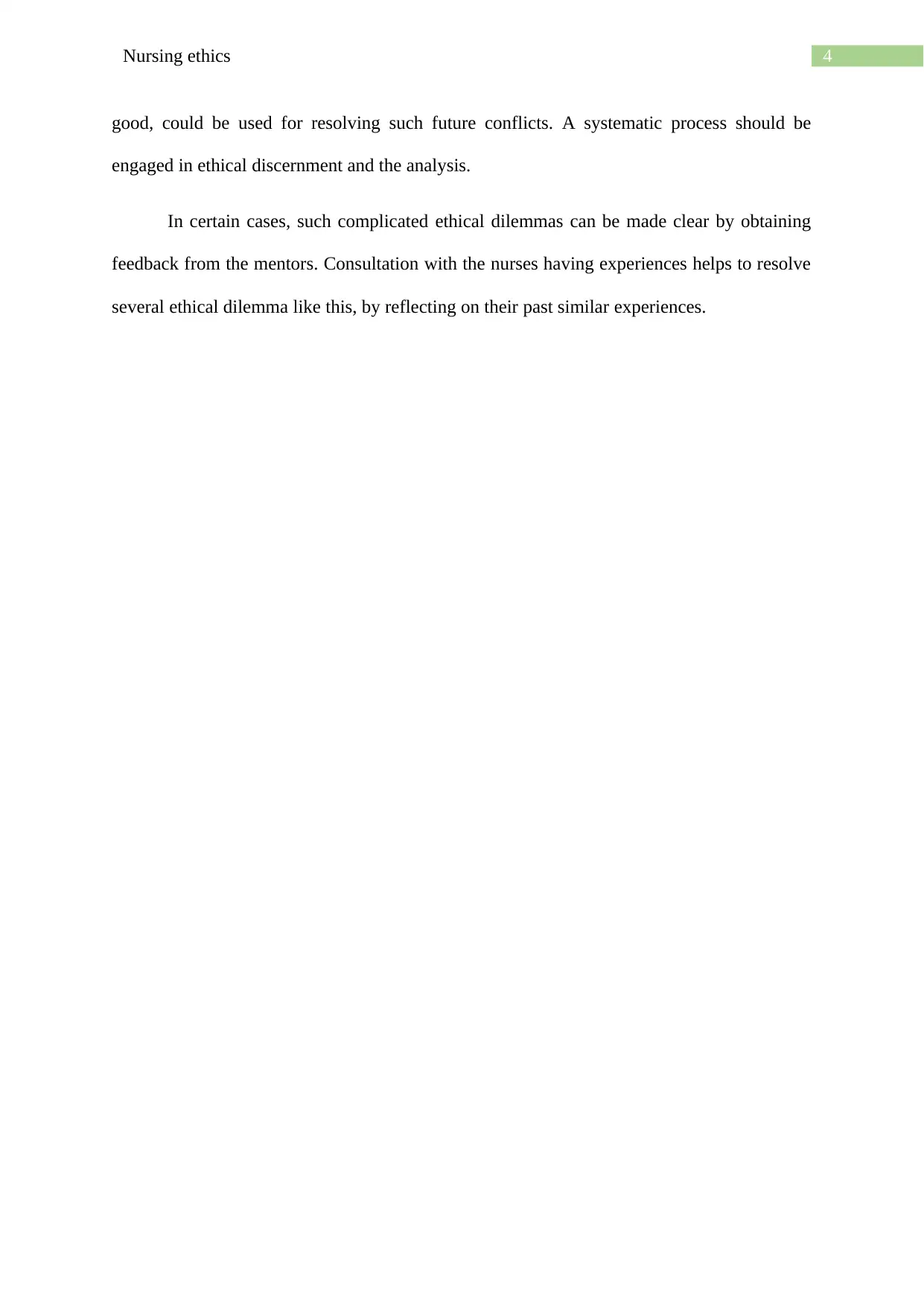
4Nursing ethics
good, could be used for resolving such future conflicts. A systematic process should be
engaged in ethical discernment and the analysis.
In certain cases, such complicated ethical dilemmas can be made clear by obtaining
feedback from the mentors. Consultation with the nurses having experiences helps to resolve
several ethical dilemma like this, by reflecting on their past similar experiences.
good, could be used for resolving such future conflicts. A systematic process should be
engaged in ethical discernment and the analysis.
In certain cases, such complicated ethical dilemmas can be made clear by obtaining
feedback from the mentors. Consultation with the nurses having experiences helps to resolve
several ethical dilemma like this, by reflecting on their past similar experiences.
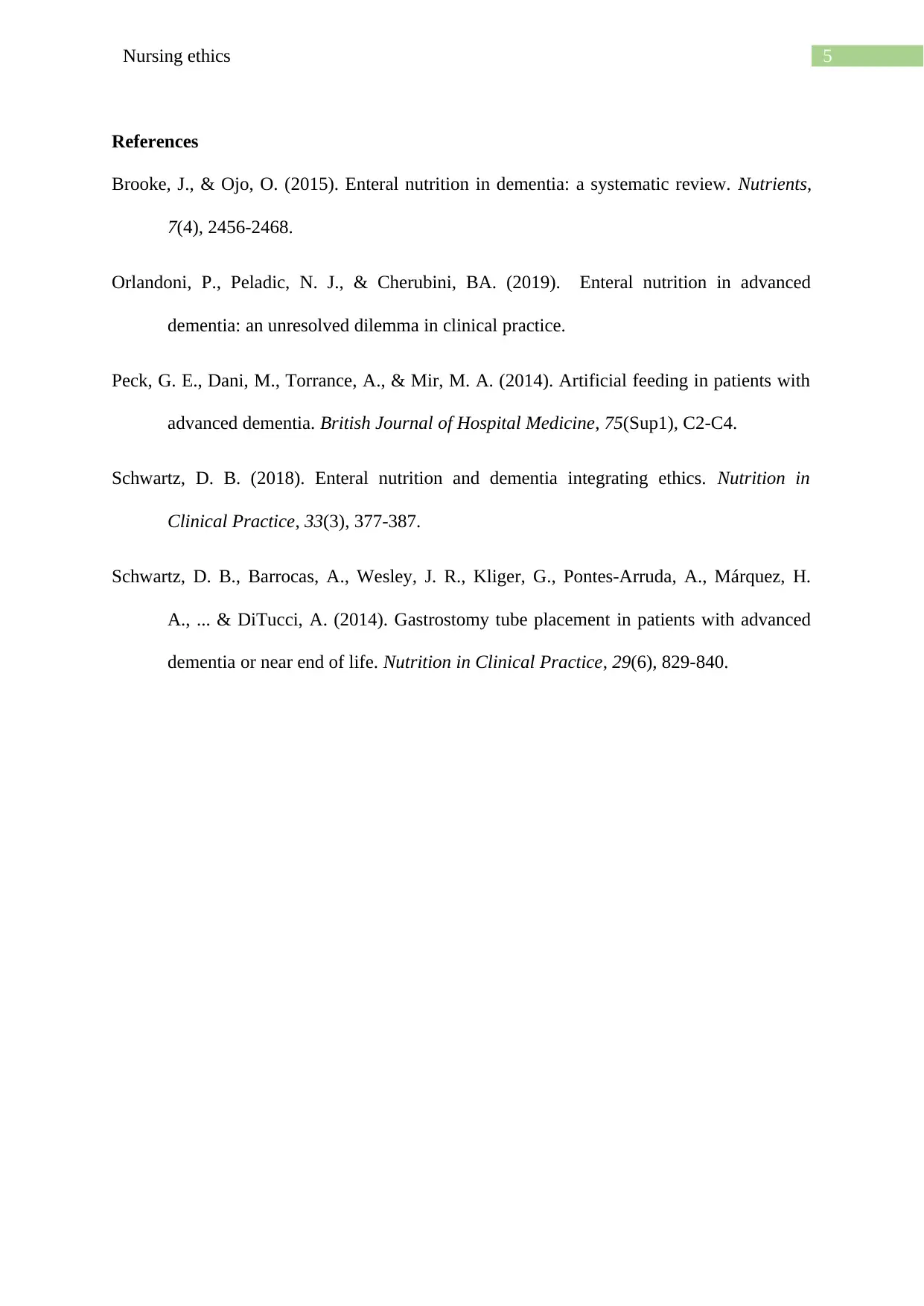
5Nursing ethics
References
Brooke, J., & Ojo, O. (2015). Enteral nutrition in dementia: a systematic review. Nutrients,
7(4), 2456-2468.
Orlandoni, P., Peladic, N. J., & Cherubini, BA. (2019). Enteral nutrition in advanced
dementia: an unresolved dilemma in clinical practice.
Peck, G. E., Dani, M., Torrance, A., & Mir, M. A. (2014). Artificial feeding in patients with
advanced dementia. British Journal of Hospital Medicine, 75(Sup1), C2-C4.
Schwartz, D. B. (2018). Enteral nutrition and dementia integrating ethics. Nutrition in
Clinical Practice, 33(3), 377-387.
Schwartz, D. B., Barrocas, A., Wesley, J. R., Kliger, G., Pontes‐Arruda, A., Márquez, H.
A., ... & DiTucci, A. (2014). Gastrostomy tube placement in patients with advanced
dementia or near end of life. Nutrition in Clinical Practice, 29(6), 829-840.
References
Brooke, J., & Ojo, O. (2015). Enteral nutrition in dementia: a systematic review. Nutrients,
7(4), 2456-2468.
Orlandoni, P., Peladic, N. J., & Cherubini, BA. (2019). Enteral nutrition in advanced
dementia: an unresolved dilemma in clinical practice.
Peck, G. E., Dani, M., Torrance, A., & Mir, M. A. (2014). Artificial feeding in patients with
advanced dementia. British Journal of Hospital Medicine, 75(Sup1), C2-C4.
Schwartz, D. B. (2018). Enteral nutrition and dementia integrating ethics. Nutrition in
Clinical Practice, 33(3), 377-387.
Schwartz, D. B., Barrocas, A., Wesley, J. R., Kliger, G., Pontes‐Arruda, A., Márquez, H.
A., ... & DiTucci, A. (2014). Gastrostomy tube placement in patients with advanced
dementia or near end of life. Nutrition in Clinical Practice, 29(6), 829-840.
⊘ This is a preview!⊘
Do you want full access?
Subscribe today to unlock all pages.

Trusted by 1+ million students worldwide
1 out of 6
Your All-in-One AI-Powered Toolkit for Academic Success.
+13062052269
info@desklib.com
Available 24*7 on WhatsApp / Email
![[object Object]](/_next/static/media/star-bottom.7253800d.svg)
Unlock your academic potential
Copyright © 2020–2025 A2Z Services. All Rights Reserved. Developed and managed by ZUCOL.
